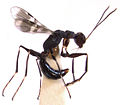Dryinidae
| Dryinidae Temporal range:
| |
|---|---|

| |
| Gonatopus alpinusfemale | |
| Scientific classification | |
| Domain: | Eukaryota |
| Kingdom: | Animalia |
| Phylum: | Arthropoda |
| Class: | Insecta |
| Order: | Hymenoptera |
| Superfamily: | Chrysidoidea |
| Family: | Dryinidae Haliday,1833 |
| Subfamilies | |
|
Anteoninae | |
Dryinidaeis a cosmopolitan family of solitarywasps.Its name comes from the Greekdrysforoak:Latreillenamed thetype genusDryinusbecause the first species was collected on an oak tree in Spain.[citation needed]The larvae areparasitoidsof the nymphs and adults ofAuchenorrhyncha.[1]Dryinidae comprises over 1900 described species, distributed in 11 extant subfamilies and 57 genera.[2][3][4]
Description
[edit]The adult wasp can measure from 0.9 to 5.0 mm in length and in some cases can reach 13 mm.[5]The body of the adult wasp has a 'waist' where it is constricted in the middle. The rear legs have spurs which may be used for grooming. The antennae have 10 segments. Many species have a markedsexual dimorphism,where males are totally different from the females in the size and shape of the body.[3][6]Males have wings while females are often wingless and resemble worker ants. Theovipositoris retractable and not visible when retracted.
Life history
[edit]The female dryinid injects anegginto the host insect with her ovipositor. Females may also have front legs modified with a pinching apparatus which they use to restrain the hosts for their larvae during oviposition. The larvae are legless or have only vestigial legs. The larva feeds on the internal structures of the host, and as it grows larger it begins to protrude from the body. It develops a hardened sac (called a "thylacium" ) around its body for protection. The host is eventually killed and the larva leaves the dead body and spins acocoon.[7]
Gallery
[edit]-
Issus coleoptratusnymph with dryinid larva under right wing
-
Dryinus koebeleifemale
See also
[edit]References
[edit]- ^Guglielmino, A.; Olmi, M.; Bückle, C. (2013). "An updated host-parasite catalogue of world Dryinidae (Hymenoptera: Chrysidoidea)".Zootaxa.3740(1): 1–113.doi:10.11646/zootaxa.3740.1.1.hdl:2067/2569.PMID25112881.S2CID12322067.
- ^Tribull, C.M. 2015. Phylogenetic relationships among the subfamilies of Dryinidae (Hymenoptera, Chrysidoidea) as reconstructed by molecular sequencing. Journal of Hymenoptera Research 45: 15–29. DOI: 10.3897/JHR.45.5010
- ^abOlmi, M.; Virla, E.G. (2014). "Dryinidae of the Neotropical region (Hymenoptera: Chrysidoidea)".Zootaxa.3792(1): 1–534.doi:10.11646/zootaxa.3792.2.1.hdl:11336/23891.PMID24869997.S2CID14181681.
- ^Olmi, M.; Xu, Z. (2015). "Dryinidae of the Eastern Palaearctic region (Hymenoptera: Chrysidoidea)".Zootaxa.3996(1): 1–253.doi:10.11646/zootaxa.3996.1.1.PMID26250320.
- ^Olmi, M.; Virla, E.G. (2006). "35. Familia Dryinidae". In Fernández, F.; Sharkey, M. J. (eds.).Introducción a los Hymenoptera de La Región Neotropical.Bogotá: Sociedad Colombiana de Entomologia y Universidad Nacional de Colombia. pp. 401–418.
- ^Olmi, M. (1994).The Dryinidae and Embolemidae (Hymenoptera: Chrysidoidea) of Fennoscandia and Denmark.Fauna Entomologica Scandinavica. Vol. 30. Brill. pp. 1–100.ISBN978-90-04-10224-8.
- ^Dryinidae.Identification of Principal Groups of Insects. Discoveries in Natural History & Exploration. UC Riverside.




